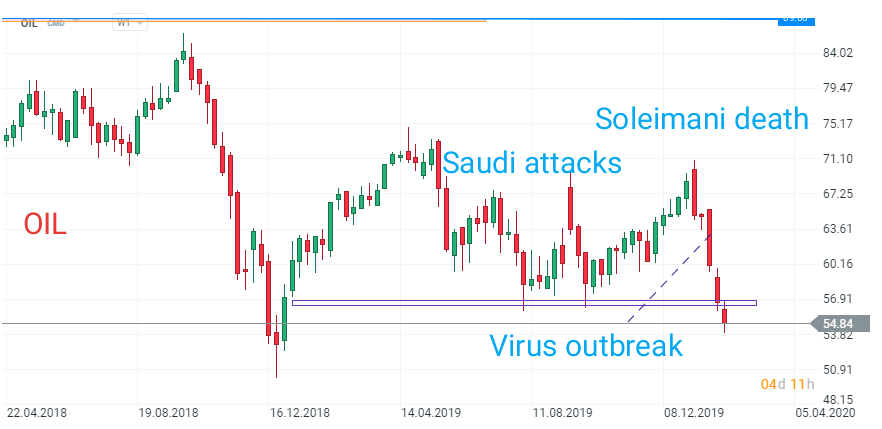Coronavirus outbreak in China is the key theme for financial markets these days. While it spreads fear across China, market reaction has been limited so far partly because it’s so hard to estimate the consequences. In this analysis we point out at evidence worth tracking as well as the key markets to watch.
A long wait for the data
The most obvious source of information should come from the Chinese government that releases statistics on sales, output and international trade. There are two problems with this. First, markets always were a bit cautious with the Chinese data that looks incredibly smooth. In this particular case the caution might be even greater. Second, the initial impact will be captured in reports for February that will be released between 29 February (the first PMI) and 16 March (output, sales). This is a long wait and investors want to know now.

China is now a much bigger economy than during the SARS outbreak and the initial transport statistics are worrisome. Source: XTB Research
That means they are left with anecdotal evidence and that’s a lot of it. First of all, we’ve heard about closures from many multinational companies like Apple, General Motors, Ikea, Starbucks, McDonald’s or Toyota. 18 Chinese steelmakers from 4 key provinces decided to curb output by 30%. Macau gambling centers were asked to close for at least 2 weeks. Many universities will delay the start of the semester until at least March. The Japanese shopping malls reported a 5-15% y/y sales decline during the Lunar New Year. There’s a lot of evidence, but it’s very hard to generalize it. Perhaps the most striking are the Lunar New Year travel statistics reported by the Transport Ministry. Initial estimates saw railway transport down by around 40% but for the whole 10-day holiday period it deteriorated to -67% y/y and air transport was down by 57%.
Two parameters to track
While there is a lot of evidence flowing from China everyday, the challenge is to put it all together. This is clear in first estimates for the GDP impact that vary from 0.6 to 1.1 percentage points. In our view, investors should focus on two things: infection numbers and production outages. The first assumption that we take is that a spread beyond China will be limited and other economies will not be paralyzed by transport and production limitations. If that assumption fails, the consequences could be dire. If it holds, it will be about returning to normal in China. Watching the number of infections seems to have a lot of sense - if the increase in infection slows down (so far it has not) it will be a sign that the virus could be contained. Production outages are very dangerous for the Chinese economy but also for trading partners. Korean Hyundai already announced a stoppage due to parts’ shortages. Korean economy, while not big, plays an important role in the Asian value added chain. So far the Hubei province faces a stoppage until 14 February while other provinces are supposed to return to work on 9 February. Extension of stoppages would have a meaningful impact and investors should track such information closely.
 A shortage of supplies could be very painful for Vietnam and South Korea and trigger a domino effect on the global economy. Source: XTB Research
A shortage of supplies could be very painful for Vietnam and South Korea and trigger a domino effect on the global economy. Source: XTB Research
Markets to watch
The economic impact of the virus will have a global impact and it will affect most of the market in more or less direct way. However, these 4 markets are especially worth watching. All 4 have already seen major sell-off and they’ll likely move sharply depending on the direction of the parameters we discussed above:
OIL, OIL.WTI - oil prices tumbled heavily as the oil market is very sensitive to changes in balance. China is by far the biggest net oil importer, responsible for more than 20% of global imports. Demand is set to decline on lower business activity and collapse of tourism. This might force the OPEC to consider additional supply cuts.

Copper - the Chinese residential market already looked challenging and if the economy suffers a setback, construction activity can decline and lower demand for copper. China was responsible for around 50% (!) of global demand for copper in 2019 so if this translates into a full-blown economic crisis, prices are set to crater.

CHNComp - profits of the Chinese companies declined by 6.3% y/y in December even before the virus broke out. The index is the most direct exposure to the Chinese economy. Key level to watch in this case is 9800.

KOSP200 - the Korean economy can be badly affected by manufacturing stoppages in China. The Korean market was rebounding nicely as the semiconductor sector started to recover but now this outlook has suddenly darkened. 273 is the key support to watch.

